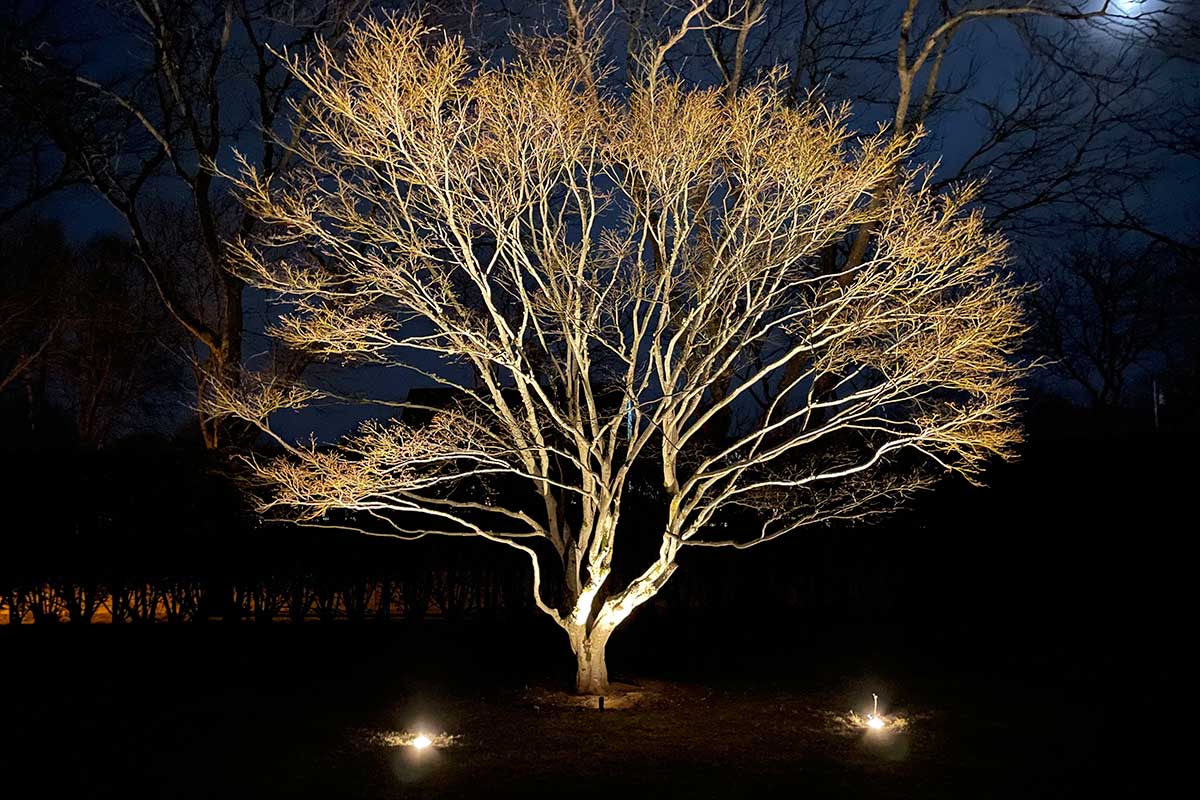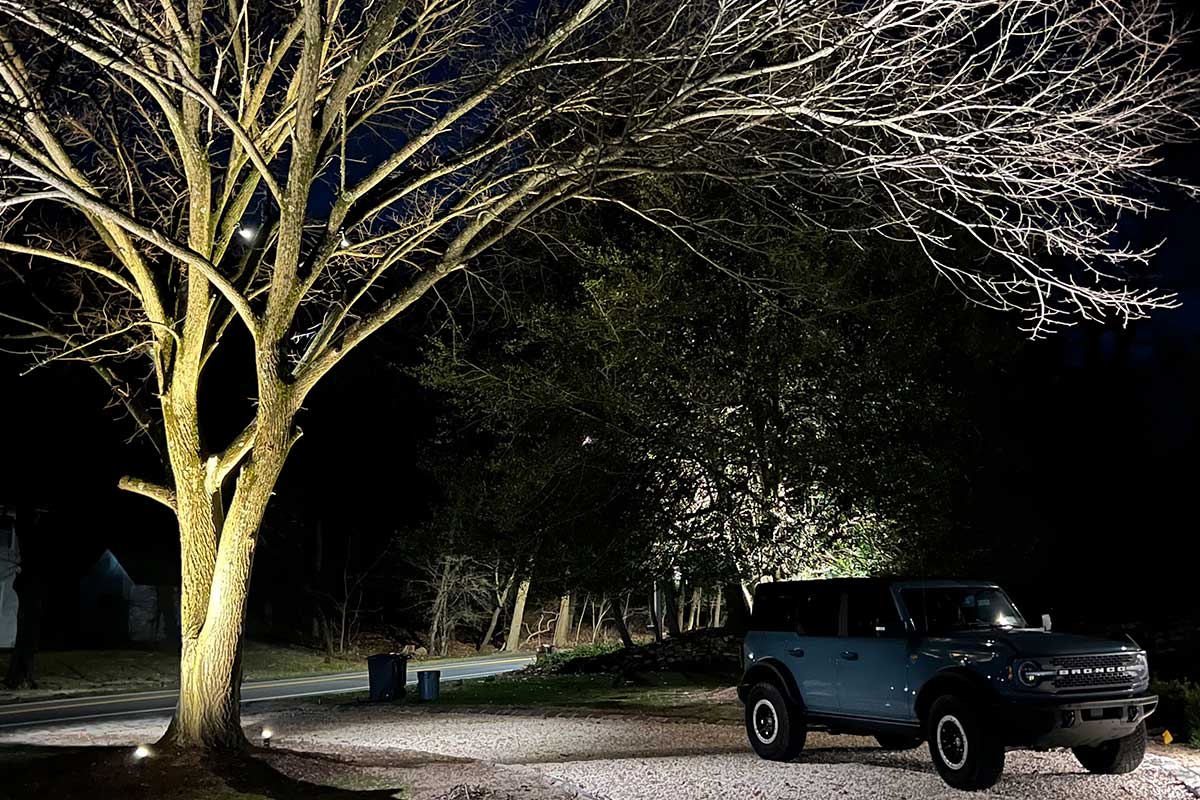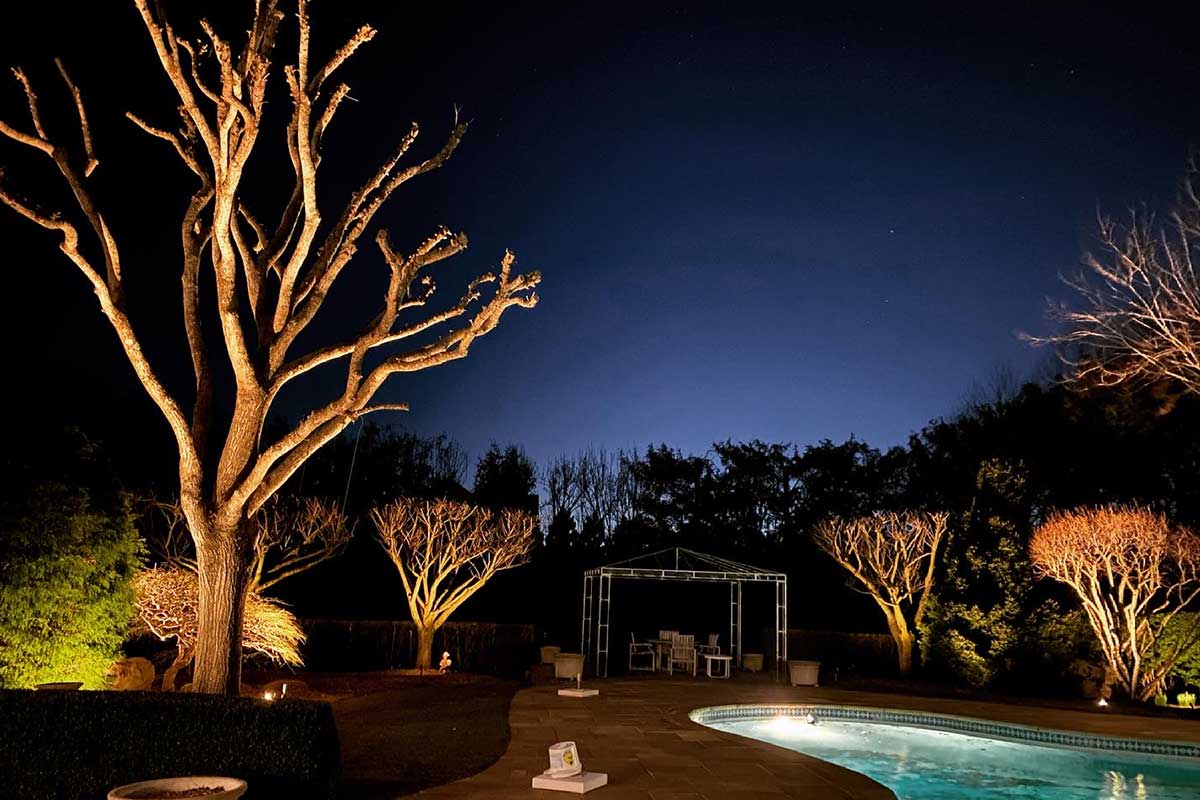Expertly designed landscape tree lighting goes above and beyond simple illumination. If we discuss it at an expert level, it’s an art for transforming your trees into captivating focal points that add depth, drama, and artistry to your property after dark. Moving past basic uplighting, it opens up a world of sophisticated effects that are ideal for bringing out the unique beauty of your trees and adding character to your entire landscape. That said, let’s start exploring some advanced techniques to get a good grasp on some of the more advanced topics of landscape tree lighting.
Layering Light to Create Depth and Drama
One of the keys to more advanced landscape tree lighting lies in the strategic layering of different lighting techniques on the same tree. While more difficult to achieve, this creates a more dynamic and three-dimensional effect than if you solely relied on a single light source. If you’re ready to dive into advanced landscape tree lighting, here are some tips for some of the more hard-to-obtain effects.
Uplighting (The Evolved Approach)
While uplighting is a fundamental technique, advanced applications will involve more refinement. Experiment with varying the distance of fixtures from the trunk. If you place them closer, you can emphasize the lower canopy and bark texture, while moving them further back can highlight the overall form. Consider using multiple uplights at different angles and with varying wattages and beam angles to sculpt the tree you envision and create intriguing shadows within its structure.
Downlighting (The Moonlight Kiss)
Achieving a natural “moonlighting” effect that perfectly mimics the moon shine involves strategically placing fixtures high in the tree canopy or on nearby structures. By directing the light downwards, this technique softly illuminates the foliage and casts gentle, steaky shadows on the ground below, copying the serene ambiance of a moonlit night. Proper shielding of the fixtures is also necessary to prevent unwanted glare and maintain a natural feel.
Silhouetting: Putting Form Against Light
To display the unique and often intricate shape of a tree, position a light source behind it and illuminate a wall, fence, or other backdrop. This setup creates a dramatic silhouette that emphasizes the tree’s outline and unique branch structure.
Grazing: Uncover the Textural Tapestry
Placing fixtures very close to the trunk and aiming the light upwards or downwards will accentuate the texture and patterns of the bark. This technique draws attention to the three-dimensional qualities of the tree and adds a tangible dimension to the visual experience. All in all, this is a great technique for highlighting the unique characteristics of different tree species.
Cross-lighting: Adding Dimension and Softening Shadows
Employing two light fixtures positioned at different angles (typically 45 degrees) can add significant depth to a tree. This technique helps to minimize harsh shadows created by a single light source and reveals more of the tree’s three-dimensional form without overpowering it with too much light.

Creating Specific and Stunning Illumination Effects
By mastering these layering techniques, you can create specific visual effects that add to the beauty and mood of your landscape. More specifically, here are some of the possible effects that you can include in your landscape tree lighting and some insights on how to apply them:
- Highlighting Unique Features: Focus your lighting on particularly interesting branches, the delicate structure of leaves, or the overall distinctive shape of the tree’s canopy to draw the eye and celebrate its individuality.
- Creating Drama and Defining Mood: The color temperature and intensity of your lights play a crucial role in setting the atmosphere. Cooler temperatures (whites and blues) can create a dramatic or even slightly graceful feel, while warmer temperatures (ambers and yellows) come with a sense of coziness and tranquility.
- Adding Depth and Visual Interest: Combining different lighting techniques on a single tree makes for a richer and more engaging visual experience, one that adds layers of light and shadow that draw the viewer in.
- Embracing Movement and Shadow Play: Even gentle breezes can create dynamic effects when light interacts with the leaves. Consider how the wind around your property will influence the movement of light and shadows, adding a natural and ever-changing element to your landscape tree lighting.
The Art of Fixture Placement and Selection
Achieving truly stunning landscape tree lighting involves a thoughtful approach to where you place your fixtures and the types of fixtures you choose. Quite often, the goal is often to let the light itself be the star, so try to conceal the physical fixtures as much as possible. Sometimes this might involve carefully burying them at the base of the tree, other times, artfully hiding them behind existing foliage.
When selecting fixtures, consider the specific effect you’re trying to create. Narrow beam spotlights are excellent for picking out individual branches or highlighting the canopy’s crown, while wider floodlights are more suitable for a general wash of light up the trunk or for creating a silhouette. Don’t underestimate the value of adjustability, and if your goal is to gain the ability to fine-tune your lighting design over time, you may prefer opting for fixtures with heads that can be tilted and swiveled for precise aiming.

Managing Control Systems for Dynamic Lighting
Modern technology is constantly coming up with new and exciting ways to manage your landscape tree lighting and creating dynamic effects that people love. One example are dimmers that provide the flexibility to adjust the intensity of your lights, allowing you to create different moods or emphasize specific features depending on the occasion. Timers are a great tool that offer the convenience of automated operation, guaranteeing that your trees are beautifully lit each evening without any manual effort needed. For those seeking ultimate control and creativity over their tree lighting, smart lighting systems open up a world of possibilities. Nowadays, they allow you to adjust colors, create custom schedules, and even program dynamic lighting sequences that bring your landscape to life in brilliantly captivating ways.
Illuminating Responsibly, Safely, and Sustainably
As you continue to explore the world of advanced landscape tree lighting techniques, it becomes more and more important to prioritize both safety and environmental consciousness. For the safest approach to outdoor lighting, stick with low-voltage systems and ensure that all wiring is properly installed and well-protected from the elements. If you want to minimize light trespass onto neighboring properties, reduce overall light pollution, and just do your part to help preserve the beauty of the night sky, you’ll have to be cautious as to how you aim your lights. Finally, embracing energy-efficient LED fixtures is a smart and reliable choice, as they consume much less power than other forms of lights and have a much longer lifespan than traditional bulbs, all of which contribute to both lower energy costs and a more sustainable approach to outdoor illumination.
Mastering advanced techniques in landscape tree lighting is an art form that can go a long way in increasing the beauty and improving the ambiance of your outdoor spaces. By moving beyond basic illumination and embracing the principles of layering, shadow play, and thoughtful fixture selection and control, you’re well on your way to transforming your trees into breathtaking nighttime features that bring your landscape to life. If you want to explore more ideas for what professionals can do with thoughtful and advanced lighting techniques, check out some completed projects in Nite-Lite’s gallery where we showcase some of our best work.
👉 Check out our full guide to the techniques and benefits of outdoor tree lighting.

